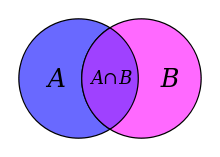Family of sets
In set theory and related branches of mathematics, a collection F of subsets of a given set S is called a family of subsets of S, or a family of sets over S. More generally, a collection of any sets whatsoever is called a family of sets.
The term "collection" is used here because, in some contexts, a family of sets may be allowed to contain repeated copies of any given member,[1][2][3] and in other contexts it may form a proper class rather than a set.
Examples
- The power set P(S) is a family of sets over S.
- The k-subsets S(k) of a set S form a family of sets.
- Let S = {a,b,c,1,2}, an example of a family of sets over S (in the multiset sense) is given by F = {A1, A2, A3, A4} where A1 = {a,b,c}, A2 = {1,2}, A3 = {1,2} and A4 = {a,b,1}.
- The class Ord of all ordinal numbers is a large family of sets; that is, it is not itself a set but instead a proper class.
Special types of set family
- A Sperner family is a family of sets in which none of the sets contains any of the others. Sperner's theorem bounds the maximum size of a Sperner family.
- A Helly family is a family of sets such that any minimal subfamily with empty intersection has bounded size. Helly's theorem states that convex sets in Euclidean spaces of bounded dimension form Helly families.
Properties
- Any family of subsets of S is itself a subset of the power set P(S) if it has no repeated members.
- Any family of sets without repetitions is a subclass of the proper class V of all sets (the universe).
- Hall's marriage theorem, due to Philip Hall gives necessary and sufficient conditions for a finite family of non-empty sets (repetitions allowed) to have a system of distinct representatives.
Related concepts
Certain types of objects from other areas of mathematics are equivalent to families of sets, in that they can be described purely as a collection of sets of objects of some type:
- A hypergraph, also called a set system, is formed by a set of vertices together with another set of hyperedges, each of which may be an arbitrary set. The hyperedges of a hypergraph form a family of sets, and any family of sets can be interpreted as a hypergraph that has the union of the sets as its vertices.
- An abstract simplicial complex is a combinatorial abstraction of the notion of a simplicial complex, a shape formed by unions of line segments, triangles, tetrahedra, and higher-dimensional simplices, joined face to face. In an abstract simplicial complex, each simplex is represented simply as the set of its vertices. Any family of finite sets without repetitions in which the subsets of any set in the family also belong to the family forms an abstract simplicial complex.
- An incidence structure consists of a set of points, a set of lines, and an (arbitrary) binary relation, called the incidence relation, specifying which points belong to which lines. An incidence structure can be specified by a family of sets (even if two distinct lines contain the same set of points), the sets of points belonging to each line, and any family of sets can be interpreted as an incidence structure in this way.
- A binary block code consists of a set of codewords, each of which is a string of 0s and 1s, all the same length. When each pair of codewords has large Hamming distance, it can be used as an error-correcting code. A block code can also be described as a family of sets, by describing each codeword as the set of positions at which it contains a 1.
See also
- Indexed family
- Class (set theory)
- Combinatorial design
- Russell's paradox (or Set of sets that do not contain themselves)
Notes
- ↑ Brualdi 2010, pg. 322
- ↑ Roberts & Tesman 2009, pg. 692
- ↑ Biggs 1985, pg. 89
References
- Biggs, Norman L. (1985), Discrete Mathematics, Oxford: Clarendon Press, ISBN 0-19-853252-0
- Brualdi, Richard A. (2010), Introductory Combinatorics (5th ed.), Upper Saddle River, NJ: Prentice Hall, ISBN 0-13-602040-2
- Roberts, Fred S.; Tesman, Barry (2009), Applied Combinatorics (2nd ed.), Boca Raton: CRC Press, ISBN 978-1-4200-9982-9
This article is issued from Wikipedia - version of the 9/3/2016. The text is available under the Creative Commons Attribution/Share Alike but additional terms may apply for the media files.
